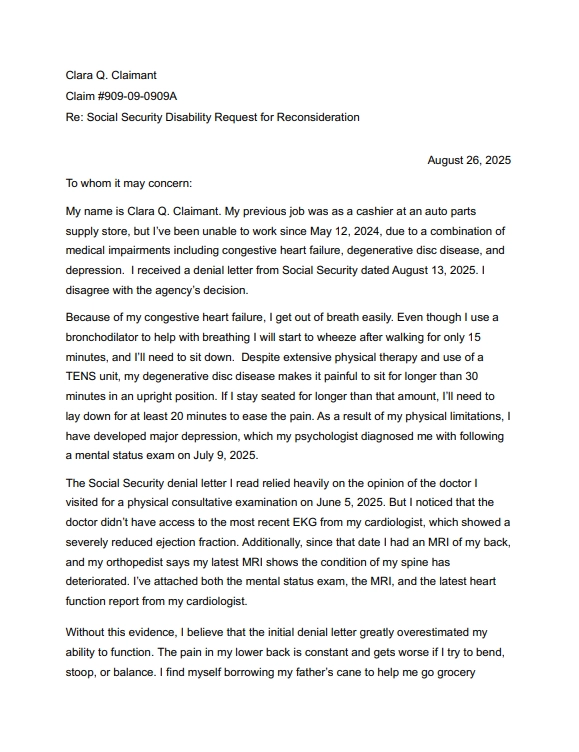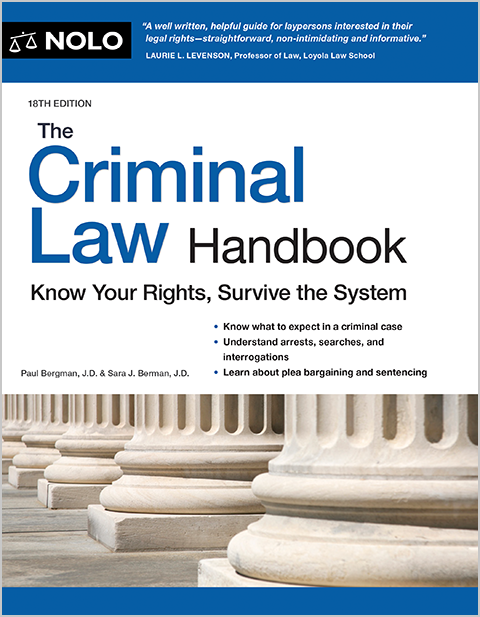Learn how to write an effective disability appeal letter, including what to say and how to say it.
Receiving an initial denial letter from Social Security can be a frustrating experience. However, you're not alone—most people aren't awarded disability benefits on their first try—and you can appeal the denial, using the opportunity to address where you think Social Security's decision was wrong. This level of appeal is called "reconsideration," and involves having a different claims examiner review your file to see if the initial examiner's decision was correct.
Few applicants take the time to write a disability appeal letter when requesting reconsideration, leaving a potentially powerful piece of evidence off the table at a critical point in the disability determination process. With a little bit of effort, you can craft a persuasive appeal letter that can make claims examiners view your case in a favorable light. But before you write anything, you'll need to do a little homework.
- What Is a Disability Appeal Letter?
- Starting Your Disability Appeal Letter: Understanding the Denial Notice
- Formatting Your Disability Appeal Letter
- What to Include In Your Disability Appeal Letter
- Sample Disability Appeal Letter for Reconsideration
- Key Tips to Strengthen Your Letter
- What If I'm Denied Again?
What Is a Disability Appeal Letter?
A disability appeal letter is pretty much what it sounds like—a written message submitted with your Social Security appeal form that explains why you're disabled and why the previous denial was incorrect.
For example, if you're appealing to the reconsideration level, you'll need to notify the Social Security Administration within 60 days of receiving the initial denial letter. The formal appeal is filed using Form SSA-561, Request for Reconsideration, but you can (and should) complete Form SSA-3441-BK, Disability Report-Appeal and submit it with your appeal request.
Form SSA-3441-BK contains 10 sections asking you to provide important information about your employment history, medical treatment, and activities of daily living. The last section (Section 10-Remarks) is a blank page where you can tell Social Security anything that wasn't covered in the previous sections that you think the agency should know about. You can also attach another sheet of paper if you need more space to describe your disability. Anything you write in Section 10 or an addendum is what's referred to as a "disability appeal letter."
Starting Your Disability Appeal Letter: Understanding the Denial Notice
Before you begin writing an appeal letter, read the denial notice you received from Social Security—you'll need to know why your claim was denied so you can write an effective appeal. The denial letter will include an explanation of determination, sometimes called the "disability determination rationale" or "technical rationale."
It's important to carefully read this rationale because understanding Social Security's reasons for denying your claim lets you know what you need to discuss in your disability appeal letter. Ideally, the explanation of determination should be written so that it's easy to understand, without complicated medical or technical terms, with reference to the following information:
- a description of your medical condition
- the specific impairment(s) Social Security evaluated
- what medical sources (like physicians' records) and non-medical (like statements from friends) were used to evaluate your claim, and
- the legal reason why your claim was denied, such as having a residual functional capacity that doesn't rule out all work.
When reading the rationale, start by looking for any errors Social Security might have made in evaluating your disability claim. Information that's vital to your claim may be missing or incorrectly reported. Keep an eye out for any of the following:
- your work history has been mischaracterized
- incorrect information about your income (for example, Social Security thinks you were earning at or above substantial gainful activity when you weren't)
- missing medical records, or
- the agency wrongly interpreted your activities of daily living.
Make a list of all the issues and errors you find so you can address them in your disability appeal letter. When possible, make reference to specific parts in your case file that you can use to support your claim. For example, if Social Security said that you can work because you don't have any functional limitations from back pain but your record contains an MRI showing severe spinal stenosis, you should draw attention to that document in your appeal letter.
Formatting Your Disability Appeal Letter
There's certain information you should include in your letter right at the beginning. Start by typing your name and claim number (this is usually your Social Security number followed by a letter code) in a header towards the top of the page. If your appeal letter is more than one page long, include this information at the top of each page. That way Social Security can still tell which file the letter belongs to if it gets separated from your appeal form.
After the header, explain briefly why you're disabled and can no longer work. Include a list of your medical conditions, a description of your symptoms, when your symptoms first began (along with the limitations you have as a result), and how your condition has changed over time. This will provide a concise synopsis of your claim for the examiner handling your case on appeal.
What to Include In Your Disability Appeal Letter
The specifics of what to include in your letter are going to vary based on your medical condition and the reason why Social Security initially denied your claim. This is where having read your denial letter thoroughly and noting mistakes the agency made will come in handy. You'll be able to have your thoughts organized in a way that makes it easier for you to counter Social Security's denial rationale. Below is a general outline of issues you should address as a basis of your appeal.
Address Any Incorrect Medical Information
Consult the list of mistakes and missing information you made when you reviewed the denial notice. For each item on the list, write a statement that points out the missing or incorrect information Social Security used to decide your claim. Don't forget that you'll need to submit the statements, records, or other information that back up your argument. Depending on your particular situation, you might need to submit the following:
- medical records that Social Security didn't take into account which show that your symptoms are more severe than indicated in the denial letter
- new medical records, including more recent diagnostic tests, showing your symptoms have become more severe since your application
- an opinion from your treating doctor explaining how the medical record supports your functional limitations, and
- any other relevant evidence, like a pain journal or headache diary.
For example, suppose the denial letter states that your shoulder injury isn't severe enough to prevent you from working because you can still lift 10 pounds, but you have trouble carrying a gallon of milk from the refrigerator to the table without dropping it—even after physical and occupational therapy. In this case, Social Security has an incorrect picture of your functional limitations. You'll need to explain that in your appeal letter and include any evidence or medical documentation you have to back up your claim.
Point Out Missing Medical Information
When Social Security includes the medical information and sources that were used to evaluate your claim, these sources should be listed very specifically by the doctor or hospital name. If you have an important medical source (like a cardiologist's report) that's not specifically mentioned in your denial rationale, Social Security probably didn't use it as a basis for their determination.
Point out in your appeal letter that you have evidence and records from your doctor that Social Security didn't take into account. If you need more time to obtain some of these new tests or documents, you can let Social Security know that you intend to submit additional evidence that supports your claim. State the specific type of evidence—such as an X-ray, lab report, or nerve conduction study—so the agency knows what to expect.
Make Sure Social Security Has the Best Evidence
If you have better sources available now than the ones Social Security used to decide your case—like more recent medical testing—you'll want to point that out in your appeal letter. (Don't forget to submit this evidence along with your appeal forms.) Likewise, if Social Security based its denial on the results of a consultative exam, you should address that in your appeal letter too. Explain why the conclusions drawn from the examination are incorrect and share the newer and better-quality evidence you have for proof.
For example, say you've been diagnosed with COPD that makes it difficult for you to breathe, especially when you're physically active or emotionally distressed. You had a consultative exam that was included in Social Security's list of medical sources in the denial letter, but since the exam you've had additional medical tests establishing that your COPD has gotten worse. These tests can make the difference between another denial and an approval of benefits, so address them in your appeal letter and submit them to the agency as soon as possible.
Make Sure Social Security Considers All Your Impairments
If you applied for disability based on multiple impairments, it's important to know that Social Security must consider the combined effect of all your impairments on your ability to work. So if your denial rationale didn't include an impairment that you're getting treatment for, you should raise this issue in your appeal letter.
As an example, suppose you have painful arthritis symptoms that make it difficult to walk as well as milder (but still significant) symptoms from asthma. If Social Security evaluated your claim based only on your arthritis, and your asthma symptoms weren't considered, you need to point that out and attach any evidence of the limitations your asthma causes.
Describe Any Mistakes in Social Security's Reasoning
It's possible that the Social Security claims examiner didn't get a clear picture of the limitations caused by your impairments. For example, the denial letter might acknowledge that you can no longer perform hobbies that require manual dexterity (like knitting or painting) due to carpal tunnel syndrome, but then states that you can still perform a desk job involving extensive typing or grasping light objects.
But if your fingers don't work well enough for you to hold onto a knitting needle or paintbrush without dropping them, it's highly unlikely that you'd be able to do a job where you'd need to use a keyboard all day or screw in small caps—and an inability to perform these types of jobs is typically considered disabling. Use your appeal letter to address any discrepancies between what Social Security says your functional limitations are and what you're actually capable of doing.
Sample Disability Appeal Letter for Reconsideration
You can click on the thumbnail below to see a sample disability appeal letter for a claimant who is requesting reconsideration of an initial denial. Remember that your appeal letter should be tailored to your medical conditions and reasons why you were denied—this sample is just a template for what an appeal letter should look like.
Key Tips to Strengthen Your Letter
It's easy to feel overwhelmed when you're writing your disability appeal letter. Not everybody expresses themselves well in writing, and communicating why you're disabled doesn't always come naturally. Here are a few useful tips you can follow to help organize your thoughts and make sure your appeal is heard.
Stand Out With Specific Examples
Disability claims examiners are often swamped with applications for common medical impairments like depression or back pain, many of which use broadly applicable descriptions like "My back hurts" or "I feel down." Make sure your letter gets attention by being specific about your limitations. If you were too depressed to attend your nephew's birthday party or you had to quit your recreational soccer team due to back pain, include these examples in your appeal.
Stay On Topic
Keep the focus of your letter on your medical treatment, your functional limitations, and why you're unable to work. While it may be tempting to complain about the doctor at your consultative exam or the length of time it's taking to get a disability decision, avoid going on these tangents. Disability examiners will be more receptive to your appeal if you can highlight the strength of your medical evidence rather than any systemic grievances.
Meet the Appeal Deadlines
Along with the explanation of determination, your denial notice will include directions on how to appeal and the deadlines you must meet. Follow all of the instructions when you file your appeal, and don't wait too long. Remember that you only have 60 days to appeal a Social Security denial, so aim to complete the forms sooner rather than later.
What If I'm Denied Again?
Nationally, only about 15% of disability claimants are approved at the reconsideration level. But you'll have to go through reconsideration in order to speak with an administrative law judge. Because about 50% of claims that are ultimately approved are awarded following a disability hearing, it's typically a good idea to appeal again so you can get one scheduled as soon as possible, rather than reapplying.
The appeal process for requesting a hearing is very similar to that of the reconsideration level. You can submit additional evidence, write another appeal letter—usually called a pre-hearing brief at this stage—and must meet the 60 day deadline to submit Form HA-501, Request for Hearing By Administrative Law Judge. You'll also need to choose your manner of hearing appearance (in-person, over the phone, or by video conference).
Most claimants at this level of appeal benefit from hiring an experienced disability attorney to help with their case. Your lawyer will know how to best prepare you to answer the judge's questions, present any "bad facts" (such as drug abuse) in a way that doesn't damage your case, and craft a persuasive theory of disability that can guide the judge towards a favorable decision. Disability lawyers don't get paid unless you win your case and many offer free consultations, so it doesn't hurt to call around until you find one near you that's a good match.
- What Is a Disability Appeal Letter?
- Starting Your Disability Appeal Letter: Understanding the Denial Notice
- Formatting Your Disability Appeal Letter
- What to Include In Your Disability Appeal Letter
- Sample Disability Appeal Letter for Reconsideration
- Key Tips to Strengthen Your Letter
- What If I’m Denied Again?


